Understand cat body language: meow is not always meow
Did you know? Just when you thought you had finally understood what your cat wants from you, the next moment it will surprise you with fully unexpected behaviour. It's enough to make a mouse cry! Cats have their very own language – which they speak both with their body and the variety of noises they make. Would you finally like to learn how to understand your cat and its emotional expressions? Here, we will show you what you have to look out for.
Cat tail language: Your cat wears its tail proudly and uses it to express a number of things
One could also refer to a cat's tail as the 'blackboard of cat body language'. By observing the position of the tail, in fact, you can recognise many emotions, intentions and needs. However, you should never observe the tail position alone. The direction of the tail may not tell you which way the wind is blowing, but it can give you some idea of your cat's mood. However, before you start looking at Kitty's tail through the eyes of a detective, you should also keep an eye on the other body language features.
Your cat may express the following emotions through its tail:
- nervousness and impatience (tail twitches occasionally or intermittently)
- well-being and happiness (tail is pointing upwards and wags occasionally and calmly back and forth)
- aggression (tail and rear half of body are raised stiffly upwards, while the front half of the body is on the ground)
- need for protection or strong tension (fur stands up and is fluffed up)
- alertness (tail wags)
- shock (tail sinks towards the ground)
- fright (tail is tilted away from the body at a flat angle)
- fear and insecurity (tail stuck between hind legs)
- playfulness or desire to hunt (tail wags from left to right)
- pain and discomfort (cat slaps tail restlessly on the floor)
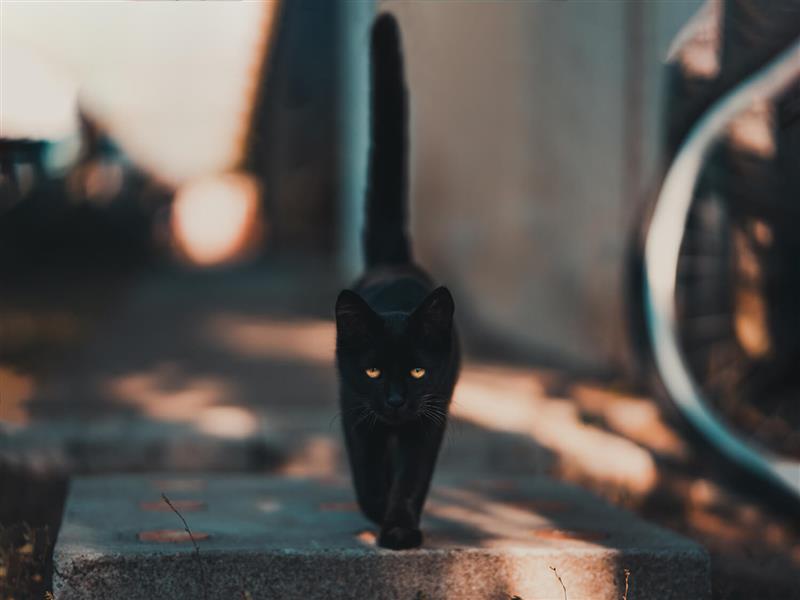
Cat eye and ear language: This is what we learn through the eyes and ears of cats
If its ears are pointing up, it will soon be up to mischief! Erect ears and wide-open eyes are clear signs that it is alert and ready to play.
Once your cat has set its sights on a hunting object, it won't be long before it snatches it up. Attack! Even just before a meal, your cat's eyes and ears will be wide open - in cat language, this means "I'm hungry!" A perfectly chilled cat, on the other hand, will have its ears pinned forward and blink slightly. You might think there is something in its eye, but in reality it is just totally relaxed and sleepy. Most cats have their eyes half closed when they are relaxed.
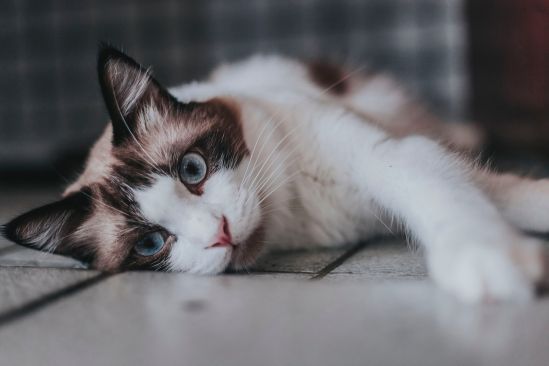
Does your cuddly tiger often suddenly turn into a fierce feline? Tension, fear or aggression are often clearly visible before the ‘attack'. This is because your cat's ears will lie close to its head or be turned to the side. In addition, its eyes are extremely wide open and it perceives every movement of its adversary. Another typical demeaning gesture is the cat's hunchback - a classic defensive posture.
Keep your distance: When your cat's back is arched and its fur is fluffed up, this signals that it wants to keep its distance. If you understand your cat's language, you should give it space. And for the sake of your skin, you should really do that. Because cat scratches can really hurt. Remember:
A twinkle in your kitty's eyes doesn't necessarily mean she's in the mood to be cuddled.
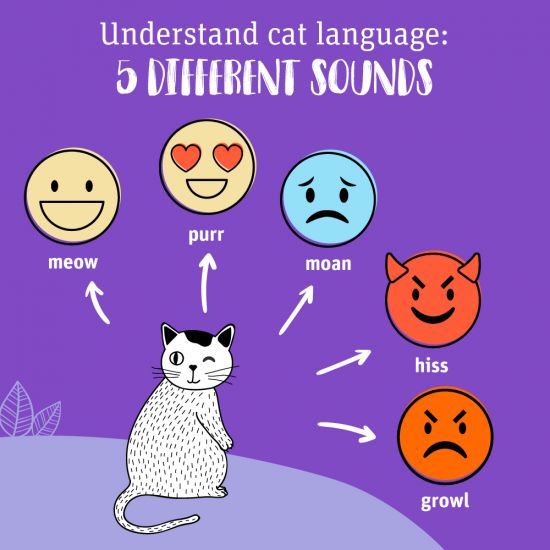
Cat language: Meowing, hissing and purring
Some cats even speak with their owners.
Not literally, of course! But while some kitties just make purring noises during the evening petting routine, others meow continuously. Such chatterboxes! When they are hungry, want to get some fresh air or simply want attention - it's meow, meow, meow! In such moments, the typical 'loud meow' can almost always be understood as a request.
However, not every sound has the same meaning and is associated with a certain mood. Cat sounds should always be interpreted in relation to their body language. That's because our felines can turn out to be true opera singers. From whiny to squeaky to deep growling – some cats are really talented musicians.
In general, however, we distinguish their sounds between meowing, whining, hissing, growling and purring. Depending on the volume, situation, duration and body language, your cat will express either tension or a sense of well-being.
Purring and hissing as classic forms of cat language
Purr me a river! Purring is in almost all cases a clear expression of security, sympathy, trust, relaxation and love. Hissing, on the other hand, clearly indicates discomfort, insecurity, defensiveness and distance through aggressiveness.
Happy cat, happy owner
What does every cat owner wish for? A happy kitty. But how can you tell that a cat is happy? If your cat lovingly snuggles around your legs and purrs and meows in bright tones, there is nothing better for it at that moment than to be stroked. As the saying goes, "Happiness is doubled when it is shared". That's what your kitty does too when it caresses you. If you're already stroking your cat, and it's also pressing its head into your hand or arching its back with pleasure at your touch, then you should delay any upcoming appointments, because your kitty adores being stroked and enjoys the time you spend together.
However, there are some other signs that your cat is happy:
- It loves its toys and loves to play with them
- It likes to snuggle up to you and purr loudly
- It rubs its nose against you
- It ‘talks' to you (frequent and loud meowing)
- It rolls and lolls on its cat tree or in the garden
- It darts around like a whirlwind when it's in the mood to play
- It eats with gusto
- It calms down quickly
- It likes to observe its surroundings closely
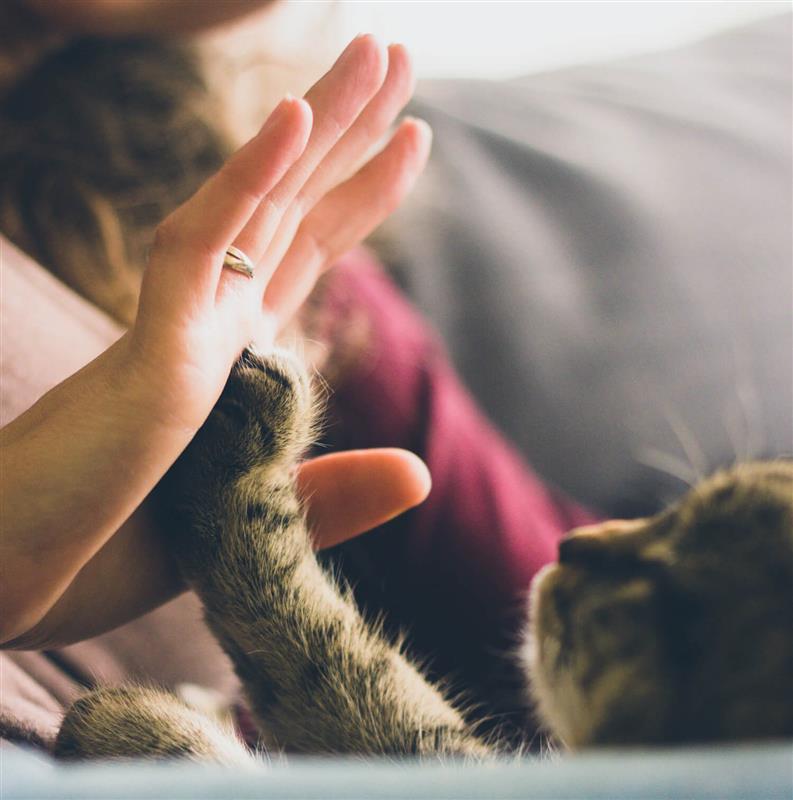
Playful nature or mini-tiger? Hunting and playing with your cat
As a novice cat linguist, you're probably wondering, "When is my kitty in hunting mode and when does she just want to play?". It is not so easy to distinguish between hunting and playing, as they are very similar in body language. This is where your eagle eye is needed: because the striking difference lies in the level of severity and seriousness. When hunting, a cat rarely lets go of its prey - it must not escape! Your mini tiger stalks its prey and attacks it in a targeted manner. Although it will "play" with a mouse or a bird until it is killed, it will act in a somewhat more serious and 'rough' manner.
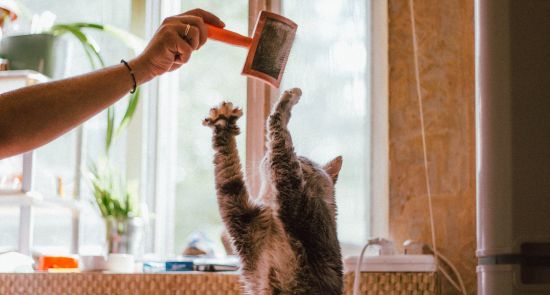
Same same but different
When playing, cats are more considerate of their toy or their opponent.
They let go of their 'play prey' from time to time, arch their back similar to when hunting and also occasionally run a little further away. When playing, the attack is more theatrical and relaxed. Sometimes, your cat will prance around its toy.
Sometimes it simply plops down on its fake prey. It will also tiptoe, stalk its toy and then attack it with full enthusiasm.
In conclusion
Although cats speak a different language from our own, it is not a secret, undecipherable code. If you want to learn and understand cat language, you must first and foremost put yourself in the position of an observer. Over time, you will get to know your cat better and better and will notice relatively quickly how it reacts in certain situations or in response to your actions. Pay attention to your cat's body language. Tail, ears, eyes and back, but also the sounds and movements it makes in the room say a lot about your cat's feelings. With a little patience, empathy and readiness to learn, you too will soon be able to understand cat language perfectly.













